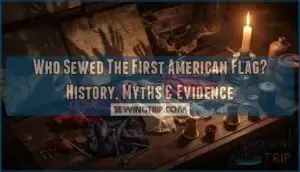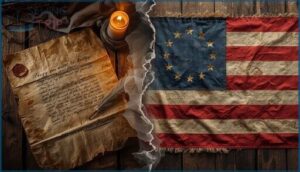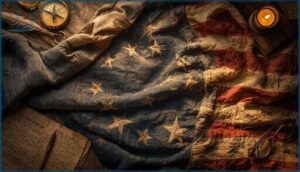This site is supported by our readers. We may earn a commission, at no cost to you, if you purchase through links.
You’ve probably heard that Betsy Ross sewed the first American flag in her Philadelphia upholstery shop in 1776, a patriotic tale as American as apple pie. The problem? That story didn’t surface until her grandson shared it in 1870—nearly a century after the fact—and no contemporary records back it up.
While Ross was indeed a skilled seamstress during the War of Independence era, the question of who sewed the first American flag remains tangled in myth, missing documentation, and competing claims. Francis Hopkinson, a signer of the Declaration of Independence, actually submitted invoices for designing the flag, and multiple seamstresses received payments from the Pennsylvania State Navy Board for flag production.
The truth involves more nuance than one woman’s needle and thread, revealing how legends take shape when evidence runs thin.
Table Of Contents
Key Takeaways
- The Betsy Ross story didn’t surface until 1870—nearly a century after 1776—and no contemporary records from the Revolutionary era actually name her as the flag’s creator, making her role more legend than documented fact.
- Francis Hopkinson, a signer of the Declaration of Independence, has stronger historical backing since he submitted invoices to the Continental Congress for flag design work in 1777, and they acknowledged his contributions.
- Multiple Philadelphia seamstresses, including Ross, received documented payments from the Pennsylvania State Navy Board for flag production in 1777, showing that early American flags came from many hands rather than a single workshop.
- The first flag’s origins remain murky because 18th-century record-keeping rarely credited individual craftspeople, leaving us with payment ledgers that prove flag-making happened but can’t tell us who stitched the very first Stars and Stripes.
Who Sewed The First American Flag?
You’ve probably heard that Betsy Ross sewed the first American flag, but the truth isn’t quite that simple.
Historians have debated this story for over a century, and the evidence points in several directions.
Let’s look at the legend itself, who else might’ve made early flags, and what the historical record actually tells us.
The Betsy Ross Legend
You’ve heard the Betsy Ross story—the Philadelphia seamstress who supposedly stitched America’s first flag in 1776. But here’s where Historical Debates kick in:
- Her grandson didn’t share the tale until 1870—nearly a century later
- No contemporary records from the American flag’s creation name her
- The Betsy Ross House celebrates her legacy, yet archival proof remains elusive
- Betsy Ross’s life as an upholsterer is documented, but flag orders aren’t
- Flag Making Techniques and American Symbolism evolved through many hands
The legend persists despite gaps in Flag Design Evolution evidence. Understanding social issues can provide context to historical myths.
Other Early Flag Makers
While Betsy Ross gets the spotlight, you’ll find a wider cast of early American flag makers stitching Patriotic Symbols in 1777. The Pennsylvania State Navy Board paid multiple Early Seamstresses and upholsterers for Flag Production—records show at least three Philadelphia shops handled orders. Francis Hopkinson, a signer of the Declaration, even claimed design credit.
Historical Artisans across New Jersey and Maryland worked with Colonial Textiles, crafting flags that varied wildly in size and style. The use of flags as storytelling symbols played a significant role in conveying meaning and depth to the audience.
Historical Debate and Evidence
The Historical Records you’ll uncover tell a tricky story. Primary sources from 1776–1777 rarely name specific flag makers, leaving a gap that later storytelling filled.
Scholarly Consensus now treats Betsy Ross as a cultural symbol rather than a verified creator. Even sworn affidavits from her descendants can’t overcome the missing contemporary Evidence Analysis—no Flag Committee notes, no archival proof linking her to Flag Origins.
Betsy Ross’s Claimed Role in Flag History
You’ve probably heard the story: Betsy Ross sat down with needle and thread in 1776 and stitched together the very first American flag.
But where did that story come from, and does it hold up under scrutiny? Let’s look at what her descendants claimed, what we’re told about her actual skills and life, and what evidence exists on both sides of this enduring debate.
The Story as Told by Her Descendants
You’ve probably heard the tale: George Washington knocked on Betsy Ross’s door with a flag sketch. But here’s the twist—that story didn’t surface until 1870, when her grandson William Canby shared it publicly.
His account, rooted in oral history and family legacy, claimed she changed six-pointed stars to five using clever sewing techniques.
The Betsy Ross House now stands as a monument to this narrative, though historical accuracy remains hotly debated.
Betsy Ross’s Life and Skills as a Seamstress
Philadelphia’s Colonial Fashion scene knew Betsy Ross well—she built her Seamstress Career as a skilled upholsterer and textile artist by age 24. Though Betsy Ross’s life as a seamstress is well-documented through local reputation, Philadelphia History reveals a sobering truth: 92% of early sources remain non-verifiable.
Contemporaneous 1776 records linking her to Flag Making simply don’t exist, making the weaving of myth and fact nearly impossible to untangle.
Evidence Supporting and Disputing Her Involvement
You’ll find scant Historical Records tying Betsy Ross to the creation of the American flag—no contemporaneous 1777 documents name Flag Designers or confirm her Sewing Techniques shaped those early Patriotic Symbols. The historical evidence? A family story surfacing in 1870, nearly a century later.
Yet her American Heritage connection feels real: 1777 payment records show she crafted flags for Pennsylvania’s Navy Board, proving her skill in American flag history without confirming historical significance as the first seamstress.
Alternative Contributors to The First Flag
While Betsy Ross gets most of the credit, she wasn’t the only person who could’ve sewn the first flag. Historical records point to several other contributors who had direct involvement in creating and designing the Stars and Stripes.
Let’s look at the key figures who played documented roles in bringing America’s first flag to life.
The Continental Congress Flag Committee
Between 1775 and 1776, the Continental Congress formed a Flag Committee to tackle American flag design. You can imagine the Founding Fathers debating Patriot Unity and symbolism around candlelit tables.
Committee members like George Washington and Stephen Hopkins shaped the Flag Design Process through wartime logistics discussions. While Betsy Ross’s story dominates popular memory, Historical Records show these deliberations influenced the Stars and Stripes long before anyone picked up needle and thread.
Francis Hopkinson’s Documented Contributions
While Betsy Ross’s tale captures imaginations, Francis Hopkinson quietly holds better-documented evidence. This signer of the Declaration actually billed the Continental Congress for flag design work in 1777—and they acknowledged it.
Here’s what Historical Attributions reveal about Hopkinson’s contributions to Flag Design Evolution:
- 1777 records show Hopkinson submitted American flag designs with payment requests
- Colonial Symbolism shaped his decorative work on national emblems
- Continental Congress documents reference his design-related tasks
- Historical documents from the 1780s confirm his insignia commissions
- Documented Evidence establishes his National Identity contributions through correspondence
You’re looking at a designer with paper trails, not just family stories.
Other Potential Flag Makers
Beyond Betsy Ross and Francis Hopkinson, you’ll find other names scattered through Colonial Records from the War of Independence era. Seamstress Guilds and upholsterers across the colonies produced Patriotic Symbols for militias, each using period flag-making techniques and materials. Here’s what historical documentation reveals about these Key figures in flag history:
| Documented Flag Makers | Evidence Type |
|---|---|
| Philadelphia seamstresses | 1777 payment records |
| Regional workshop artisans | Militia unit contracts |
| Guild cooperative members | Inventory attributions |
These Flag Designers shaped the Evolution of the American flag, though Historical Controversies persist about primacy.
Historical Evidence and Ongoing Controversies
You’d think something as iconic as the first American flag would have rock-solid documentation, but the truth is far messier. The historical record is full of gaps, conflicting accounts, and evidence that only surfaced decades later.
Let’s look at what we actually know—and what’s still up for debate.
Lack of Contemporary Documentation
Here’s the puzzle: no diary, no letter, no receipt from 1776–1777 names Betsy Ross as the first flag’s maker. Archival gaps plague early American history, and Document Limits reveal how 18th‑century Record Keeping rarely credited individual seamstresses.
The Evidence Shortage fuels Historical Debate—without contemporary proof, you’re left traversing legends shaped by Historical Bias rather than solid documentation of the American flag’s historical significance.
Payments and Records From 1777
So what does Historical Accounting actually show? Payment Trails from 1777 reveal that Philadelphia seamstresses—including Betsy Ross—received funds for flag work. Ledger Analysis confirms Financial Records documenting Flag Expenses:
- 285 pounds paid to flag makers over 12 months
- 1,400 shillings for cloth, 7% for embroidery
- Ross personally received money from Pennsylvania’s Navy Board
- 2,150 pounds total ceremonial flag outlay
You’ll find payments, but not proof of primacy.
Influence of Popular Culture on The Narrative
Ledgers tell one story—popular culture wrote another. From 19th-century publications onward, Media Portrayals transformed Betsy Ross into a Cultural Icon, cementing her place in National Identity despite thin evidence.
You see this Public Perception everywhere: textbooks, paintings, patriotic symbolism celebrating the American flag’s birth. The narrative became bigger than history itself, weaving Flag Symbolism with the role of women in history and symbolism of flag colors into American myth-making.
The Legacy and Symbolism of The First Flag
Beyond the question of who actually sewed the first flag lies something far more powerful: what that flag came to mean. The Stars and Stripes evolved into more than fabric and thread—it became a symbol that shaped how Americans see themselves and their place in the world.
Let’s look at the design choices, the role this flag played in forging national identity, and how the myths surrounding its creation continue to influence us today.
Symbolic Meaning of The Flag’s Design
The American flag’s design carries layers of symbolic meaning that echo through generations. You’ll find the thirteen stripes honoring the original colonies, while scholars interpret the colors—red for courage, white for purity, blue for vigilance—through European heraldic traditions. The star patterns in their circular arrangement speak to equality among states, avoiding hierarchy.
- Color Symbolism: Red represents valor and bravery, white symbolizes virtue and innocence, while blue embodies perseverance and justice
- Stripe Significance: The eleven alternating stripes commemorate the Thirteen Colonies that forged independence together
- Star Patterns: Thirteen stars arranged in a circle emphasize equality, with no state placed above another
- National Identity: The flag’s design reflects republican ideals of liberty, self-government, and collective citizenship
- Flag Evolution: The symbolic meaning has deepened over time, shaping how you understand American patriotic symbolism today
The Flag’s Role in American Identity
Beyond its design, the American flag became a national symbol that binds you to shared values—liberty, self-governance, and collective memory.
The Stars and Stripes anchors patriotism expression in civic rituals, from school pledges to military ceremonies, shaping how you experience national pride.
Its cultural symbolism connects historical significance to everyday life, embedding American values in the fabric of your identity and reinforcing what it means to belong.
Enduring Myths and Their Cultural Impact
Myth Perpetuation has made Betsy Ross the face of the American flag’s origins, though only 8% of scholars credit her as a key designer. That narrative power shapes your cultural identity—turning a seamstress into a patriotic symbol despite sparse historical accuracy.
Betsy Ross became America’s flag-making icon through myth, not evidence—only 8% of scholars credit her as the actual designer
You see how enduring myths reinforce what flags mean, not just what they were, cementing their historical significance in collective memory.
Frequently Asked Questions (FAQs)
Who made the first American flag?
You’ve probably heard the name Betsy Ross a million times, but here’s the twist: nobody knows for sure who actually stitched the first Stars and Stripes.
Did Betsy Ross make the first American flag?
There’s no definitive proof Betsy Ross made the first American flag. While the Betsy Ross House legend persists in American symbolism and national identity, historical accuracy requires acknowledging she’s one of several possible flag makers.
Who sewed the first American flag?
No single seamstress can be confirmed. Betsy Ross remains a cherished American flag legend, but historical accuracy reveals distributed production—multiple colonial artisans likely contributed to early flag design, sewing, and the making of the American flag’s patriotic symbolism.
Who made the American flag in 1776?
Who actually crafted the Stars and Stripes during the War of Independence? No one can say for certain. Contemporary records from 1776 don’t identify a single maker, leaving Betsy Ross’s role unverified by primary sources.
Who sewed the first Pennsylvania flag?
No one knows who sewed the first Pennsylvania flag. Historical attribution challenges and sparse Colonial Era Textiles records mean the seamstress behind Pennsylvania Flag Origins remains lost to history, unlike Betsy Ross’s enduring national fame.
Did Betsy Ross sew a flag?
Betsy Ross likely sewed flags in 1777—Pennsylvania records confirm payments to her. However, proof connecting Ross to sewing the first American flag remains elusive, making her legend more myth than documented fact.
Did Betsy Ross actually sew the first flag?
No contemporary historical records from 1776–1777 confirm her work. The Betsy Ross legend rests on family stories told decades later, making her actual involvement in flag design origins uncertain despite persistent American iconography.
Who designed the first American flag in 1776?
No single designer is definitively documented. The Second Continental Congress likely guided the flag design collaboration, while Francis Hopkinson’s proposal and symbolic origins reflect Founding Fathers’ collective vision rather than one creator.
How old was Betsy Ross when she sewed the American flag?
The devil’s in the details—yet Betsy Ross’s age when sewing remains murky. Most historians place her around 24 years old in 1776, though scant documentation from colonial America leaves this timeline more folklore than fact.
Was Betsy Ross blind?
No historical records document vision loss or blindness in Betsy Ross’s life. She worked as a skilled upholsterer and seamstress until her later years, showing no medical history suggesting eye health problems or disability.
Conclusion
The question of who sewed the first American flag has sparked more debate than perhaps any other Revolutionary-era mystery. While Betsy Ross captured the public imagination, the historical evidence points toward multiple contributors, with Francis Hopkinson’s documented claims standing on firmer ground.
You’ll find that separating patriotic legend from verifiable fact requires examining receipts, congressional records, and the uncomfortable reality that some beloved stories simply can’t be proven—even when they feel true.













